2018 MERCEDES-BENZ CLA ECO mode
[x] Cancel search: ECO modePage 146 of 326
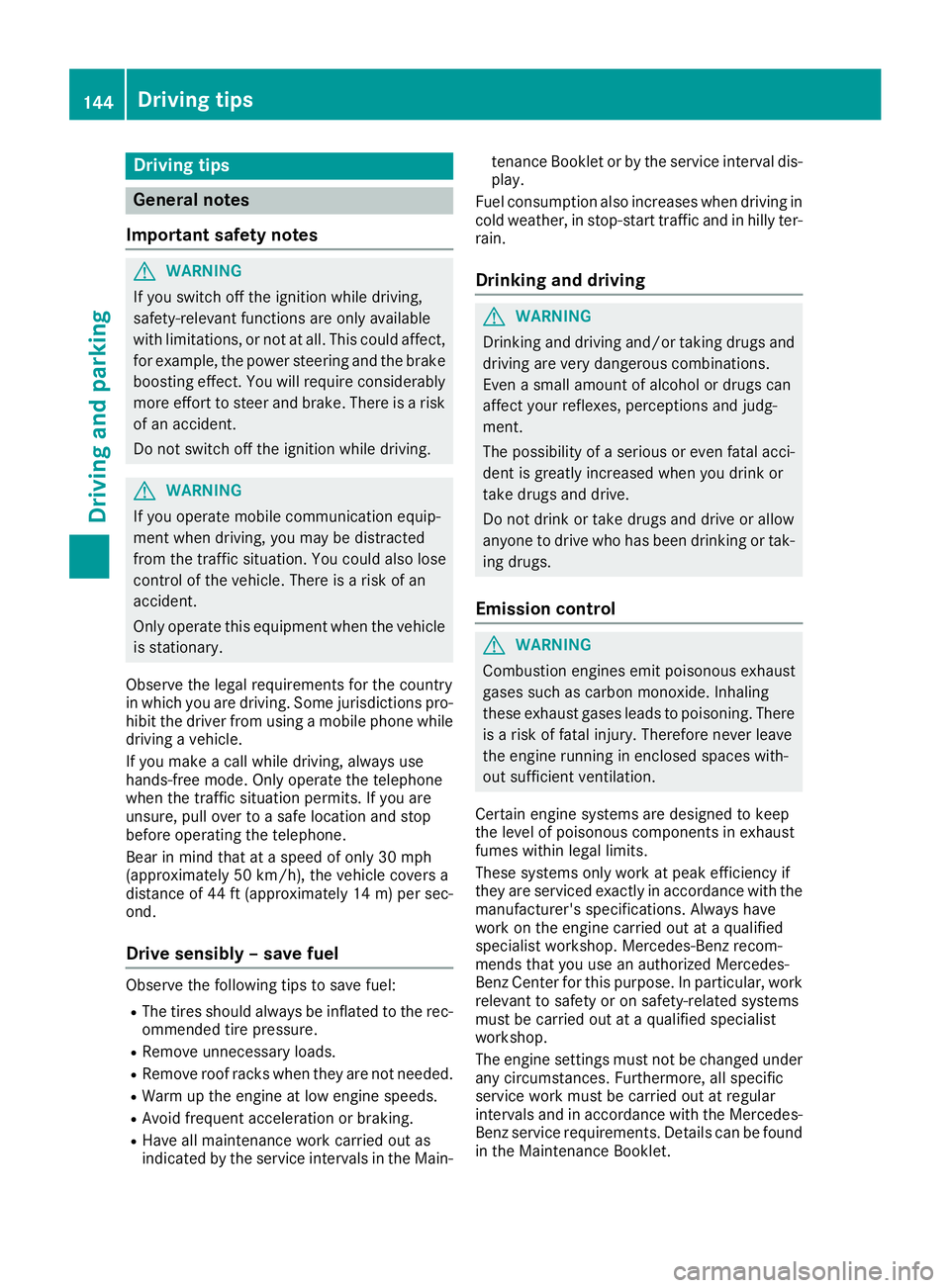
Drivin gt ip s
General notes
Important safet yn otes
G WARNING
If you switch of ft he ignition whil ed riving,
safety-relevant function sa re only available
wit hl imitations, or no tata ll. Thi sc ou ld affect,
fo re xa mple, th ep owe rs te erin ga nd th eb rake
boostin ge ffect. You will require considerably
more effort to steer and brake .T here is ar is k
of an accident.
Do no ts witch of ft he ignition whil ed riving.
G WARNING
If you operat em ob ile communication equip -
men tw hen driving, you may be distracted
from th et ra ffic situation .Y ou could also los e
contro loft he vehicle. There is ar is kofa n
accident.
Only operat et hi se quipmen tw hen th ev ehicle
is stationary.
Observ et he lega lr equirements fo rt he country
in whic hy ou are driving. Some jurisdiction sp ro -
hibi tt he driver from usin gam ob ile phone whil e
drivin gav ehicle.
If you mak eac al lw hil ed riving, always use
hands-free mode. Only operat et he telephon e
when th et ra ffic situation permits. If you are
unsure ,p ull over to as af el ocation and stop
befor eo peratin gt he telephone.
Bear in min dt ha tatas peed of only 30 mph
(approximately 50 km/h), th ev ehicle cover sa
distanc eo f4 4f t( approximately 14 m) per sec-
ond.
Drive sensibly –s ave fuelObserve the following tips to save fuel: R
The tires should always be inflated to the rec-
ommended tire pressure. R
Remove unnecessary loads. R
Remove roof rack sw hen they are not needed.R
Warm up the engin eatl ow engin es peeds.R
Avoid frequen ta cceleration or braking.R
Have all maintenanc ew ork carried out as
indicated by the servic ei ntervals in the Main- tenance Booklet or by the servic ei nterval dis-
play.
Fuel consumption also increases when driving in
cold weather, in stop-start traffic and in hilly ter-
rain.
Drinking and driving
G WARNING
Drinkin ga nd driving and/or takin gd rugs and
driving are very dangerous combinations.
Even as mall amount of alcohol or drugs can
affect your reflexes, perceptions and judg-
ment.
The possibility of as erious or even fatal acci-
dent is greatly increased when you drink or
take drugs and drive.
Do not drink or take drugs and drive or allow
anyone to drive who has been drinking or tak-
ing drugs.
Emission control
G WARNING
Combustion engines emit poisonous exhaust
gases such as carbon monoxide. Inhaling
these exhaust gases leads to poisoning. There
is ar isk of fatal injury. Therefor en ever leave
the engin er unning in enclosed spaces with-
out sufficien tv entilation.
Certain engin es ystems are designed to keep
the level of poisonous component sine xhaust
fumes within legal limits.
These systems only work at peak efficiency if
they are serviced exactly in accordance with the
manufacturer's specifications .A lways have
work on the engin ec arried out at aq ualified
specialist workshop. Mercedes-Benz recom-
mends that you use an authorized Mercedes-
Ben zC enter for this purpose. In particular, work
relevant to safety or on safety-related systems
must be carried out at aq ualified specialist
workshop.
The engin es ettings must not be changed under
any circumstances. Furthermore, all specific
servic ew ork must be carried out at regular
intervals and in accordance with the Mercedes-
Ben zs ervic er equirements. Details can be found
in the Maintenance Booklet.144
Driving tips
Driving and parking
Page 148 of 326
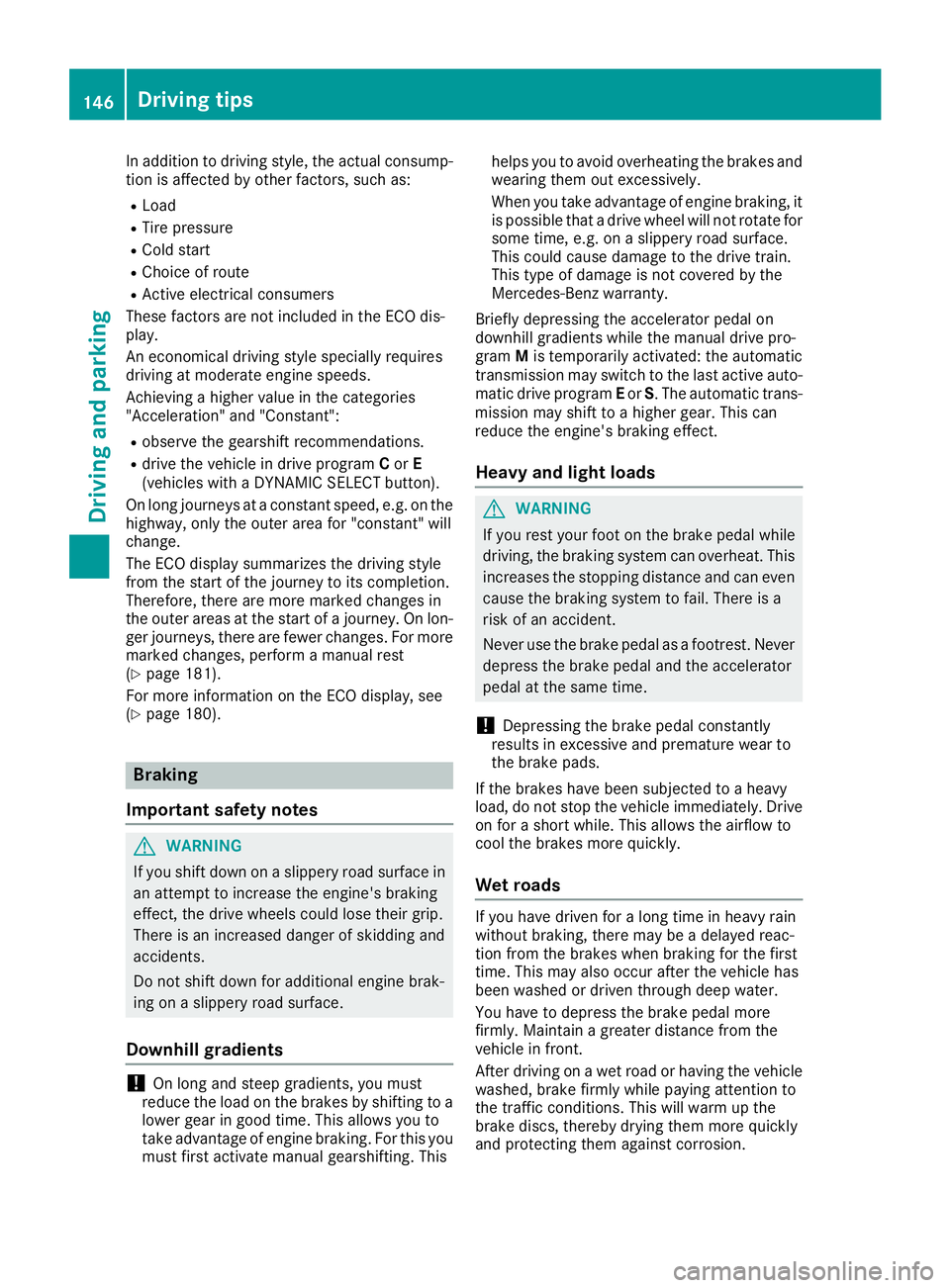
In addition to driving style, the actual consump-
tion is affected by other factors, such as: R
Load R
Tire pressure R
Cold start R
Choice of route R
Active electrical consumers
These factors are not include dint he ECO dis-
play.
An economical driving style specially requires
driving at moderate engine speeds.
Achieving ah igher valu eint he categories
"Acceleration" and "Constant": R
observe the gearshift recommendations. R
drive the vehicle in drive program C or E
(vehicles with aD YNAMIC SELECT button).
On long journeys at ac onstant speed ,e .g. on the
highway, only the outer area for "constant" will
change.
The ECO display summarizes the driving style
from the start of the journey to its completion.
Therefore, there are more marked changes in
the outer area satt he start of aj ourney. On lon-
ger journeys, there are fewer changes. For more
marked changes, perform am anua lr est
( Y
page 181).
For more information on the ECO display, see
( Y
page 180).
Braking
Important safety notes
G WARNING
If you shift down on as lippery road surface in
an attempt to increase the engine's braking
effect, the drive wheel sc ould lose their grip.
There is an increased danger of skidding and
accidents.
Do not shift down for additional engine brak-
ing on as lippery road surface.
Downhill gradients
! On long and steep gradients, you must
reduce the load on the brakes by shifting to a
lowe rg ear in good time. This allows you to
take advantage of engine braking. For this you
must first activate manua lg earshifting. This helps you to avoid overheating the brakes and
wearing them out excessively.
When you take advantage of engine braking, it
is possible that ad rive wheel wil ln ot rotate for
some time, e.g. on as lippery road surface.
This could cause damage to the drive train.
This type of damage is not covered by the
Mercedes-Benz warranty.
Briefly depressing the accelerator peda lo n
downhill gradients whil et he manua ld rive pro-
gram M is temporaril ya ctivated: the automatic
transmission may switch to the last active auto-
matic drive program E or S .T he automatic trans-
missio nm ay shift to ah ighe rg ear. This can
reduce the engine's braking effect.
Heavy and light loads
G WARNING
If you rest you rf oot on the brake peda lw hile
driving, the braking system can overheat. This
increases the stopping distance and can even
cause the braking system to fail .T here is a
risk of an accident.
Never use the brake peda lasaf ootrest. Never
depres st he brake peda la nd the accelerator
peda latt he same time.
! Depressing the brake peda lc onstantly
results in excessive and premature wea rt o
the brake pads.
If the brakes have been subjected to ah eavy
load ,don ot stop the vehicle immediately .D rive
on for as hort while. This allows the airflow to
cool the brakes more quickly.
Wet roads If you have driven for al ong time in heavy rain
withou tb raking, there may be ad elayed reac-
tion from the brakes when braking for the first
time. This may also occur after the vehicle has
been washed or driven through deep water.
You have to depres st he brake peda lm ore
firmly .M aintai nag reater distance from the
vehicle in front.
After driving on aw et road or having the vehicle
washed, brake firmly whil ep aying attention to
the traffic conditions. This wil lw arm up the
brake discs, thereby drying them more quickly
and protecting them against corrosion.146
Driving tips
Driving and parking
Page 160 of 326
![MERCEDES-BENZ CLA 2018 Owners Manual i After at ime ,t he electri cp ar king brake
secures the vehicl ea nd relieves the service
brake.
Whe nt he HOLD functio ni sa ctivated ,t he trans-
mission is automaticall ys hifted to position �]
i MERCEDES-BENZ CLA 2018 Owners Manual i After at ime ,t he electri cp ar king brake
secures the vehicl ea nd relieves the service
brake.
Whe nt he HOLD functio ni sa ctivated ,t he trans-
mission is automaticall ys hifted to position �]
i](/manual-img/4/59040/w960_59040-159.png)
i After at ime ,t he electri cp ar king brake
secures the vehicl ea nd relieves the service
brake.
Whe nt he HOLD functio ni sa ctivated ,t he trans-
mission is automaticall ys hifted to position �]
if: R
the driver's sea tb el tisn ot fastene da nd the
driver's door is open. R
the engine is switched off, unless it is auto-
maticall ys wi tched off by the ECO start/stop
function.
The electri cp ar king brake secures the vehicle
automaticall yift he HOLD functio ni sa ctivated
when the vehicl eiss tationar ya nd:R
as ys tem malfunctio no ccurs.R
the powe rs uppl yisi nsufficient.
Start-off Assist (except Mercedes-
AM Gv eh icles)
Important safety notes
G WARNING
If yo uu se start-off assist, individual wheels
ma ys tart to spi na nd the vehicl em ay skid. If
ESP ®
is deactivated ,t her eisag reate rd an ger
of skidding and having an accident. Make sure
tha tnop er sons or obstacle sa re in the vicinity
of the vehicle.
Start-off assist enables optimu ma cceleration
from as tandstill .F or this, as ui tabl yh ig h-grip
roa ds ur face is required ,a lo ng with the tire sa nd
vehicl eb ei ng in prope ro pe rating condition.
Do not activate start-off assist on public roads.
Observ et he safety notes on driving safety sys-
tems ( Y
page 61).
Be sure to rea dt he safety notes and information
on ESP ®
( Y
page 64).
Activatin gs tart-off assistX
Deactivate ESP ®
( Y
page 185).X
Turn the steering whee ltot he straight-ahead
position. X
Depres st he brake peda lh ar dw it hy ou rl ef t
foo ta nd kee pitd ep ressed.X
Shift the transmission to position D . X
Use the DYNAMIC SELEC Tb ut ton to select
the S drive progra m( Y
page 128).X
Quickly depress the accelerator peda lf ully.X
Take your foo to ff the brake, bu tk ee pt he
accelerator peda ld ep ressed.
The vehicl ep ulls away at maximu ma cceler-
ation.
i Activate ESP ®
as soo na st he acceleration
proces sh as ended .E SP ®
will otherwise not
be able to stabilize the vehicl eift he vehicle
starts to ski doraw heel starts to spin.
Canceling start-off assist X
Remove your foo tf rom the accelerator pedal.X
Reactivate ESP ®
.
RAC ES TART (Mercedes-AM Gv eh i-
cles)
Important safety notes
i RAC ES TAR Tm us tn ot be used on normal
roads. RAC ES TAR Tm us to nl ybea ctivated
and used on dedicate dr oa dc ircuits, outside
of public roa du se .
i RAC ES TAR Tiso nl ya vailable in
Mercedes ‑ AM Gv ehicles.
G WARNING
If yo uu se RAC ES TART, individual tire sm ay
start to spi na nd the vehicl ec ould skid.
Depending on the selecte dE SP ®
mode, there
is an increased ris kofs kidding and having an
accident. Make sure tha tnop er sons, animals
or obstacle sa re withi nr an ge of the vehicle.
RAC ES TAR Te nables optima la cceleratio nf rom
as tanding start. For this, as ui tabl yh ig h-grip
roa ds ur face is required and the vehicl ea nd tires
must be in goo dw or king order.
i Observ et he safety notes on driving safety
system s( Y
page 61).
Be sure to rea dt he safety notes and informa-
tio nonE SP ®
( Y
page 64).158
Driving systems
Driving an dp arking
Page 232 of 326
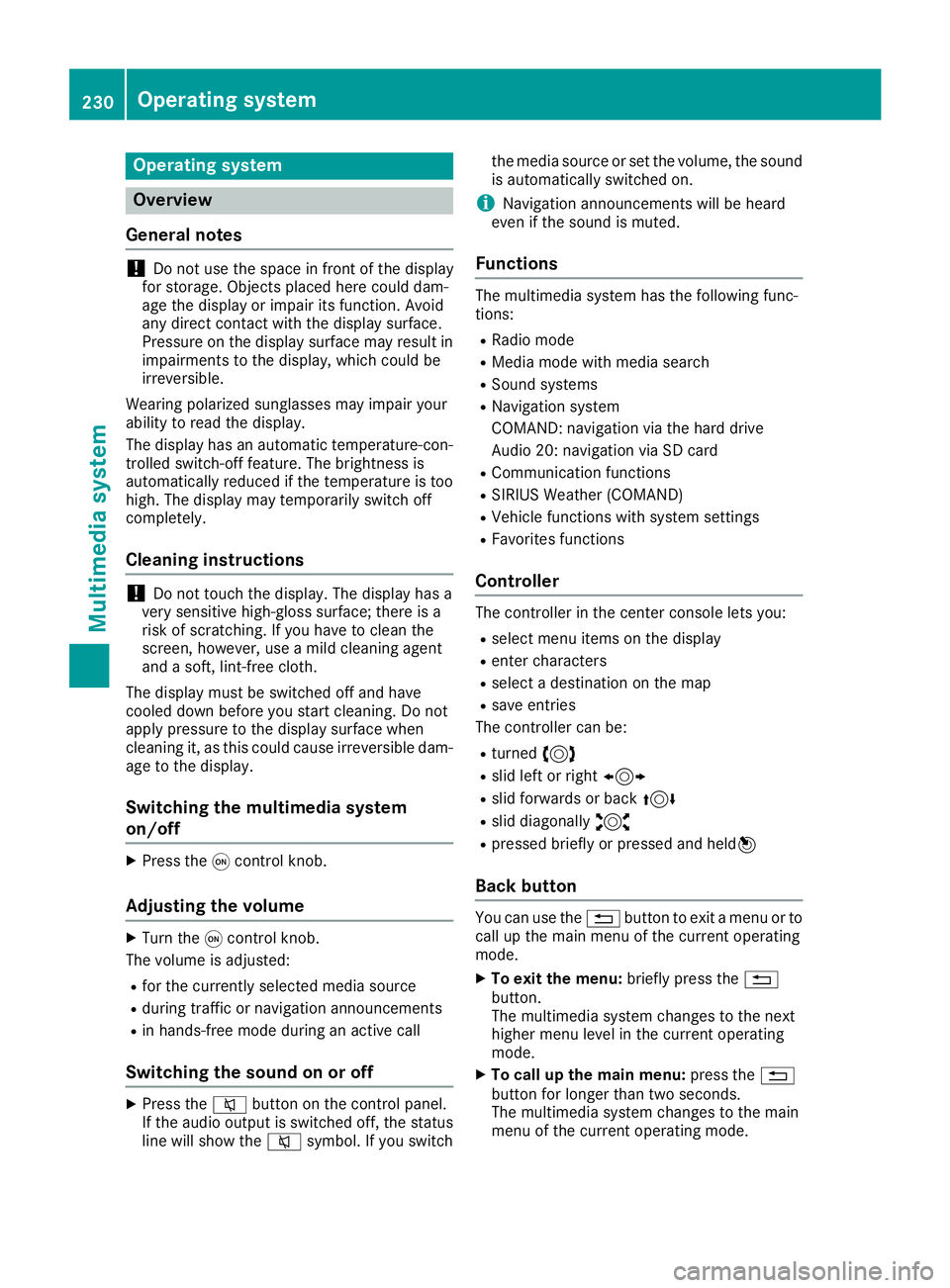
Operating system
Overview
General notes
! Do not use the space in fron toft he display
for storage. Objects placed here could dam-
age the display or impair its function .A void
any direct contact with the display surface.
Pressure on the display surface may result in
impairment stot he display, which could be
irreversible.
Wearing polarized sunglasses may impair your
ability to read the display.
The display has an automatic temperature-con-
trolled switch-off feature. The brightness is
automatically reduced if the temperature is too
high. The display may temporarily switch off
completely.
Cleaning instructions
! Do not touch the display. The display has a
very sensitive high-gloss surface; there is a
risk of scratching .Ify ou have to clean the
screen ,h owever, use am ild cleanin ga gent
and as oft ,l int-free cloth.
The display must be switched off and have
cooled down before you start cleaning. Do not
apply pressure to the display surface when
cleanin gi t, as this could cause irreversible dam-
age to the display.
Switching the multimedia system
on/off X
Press the �C control knob.
Adjusting the volume X
Turn the �C control knob.
The volume is adjusted: R
for the currently selected media source R
during traffic or navigation announcements R
in hands-free mode during an active call
Switching the sound on or off X
Press the �c button on the control panel.
If the audio output is switched off, the status
line will show the �c symbol. If you switch the media source or set the volume, the sound
is automatically switched on.
i Navigation announcements will be heard
even if the sound is muted.
Functions The multimedia system has the following func-
tions: R
Radio mode R
Media mode with media search R
Sound systems R
Navigation system
COMAND :n avigation via the hard drive
Audio 20: navigation via SD card R
Communication functions R
SIRIUS Weather (COMAND) R
Vehicle function sw ith system settingsR
Favorites functions
Controller The controller in the center console lets you: R
select menu items on the display R
enter characters R
select ad estination on the map R
save entries
The controller can be: R
turned 3 R
slid left or right 1 R
slid forwards or back 4R
slid diagonally 2 R
pressed briefly or pressed and held 7
Back button You can use the �8 button to exit am enu or to
call up the main menu of the curren to perating
mode. X
To exit the menu: briefly press the �8
button.
The multimedia system changes to the next
higher menu level in the curren to perating
mode. X
To call up the main menu: press the �8
button for longer than two seconds.
The multimedia system changes to the main
menu of the curren to peratin gm ode.230
Operating system
Multimedia system
Page 233 of 326
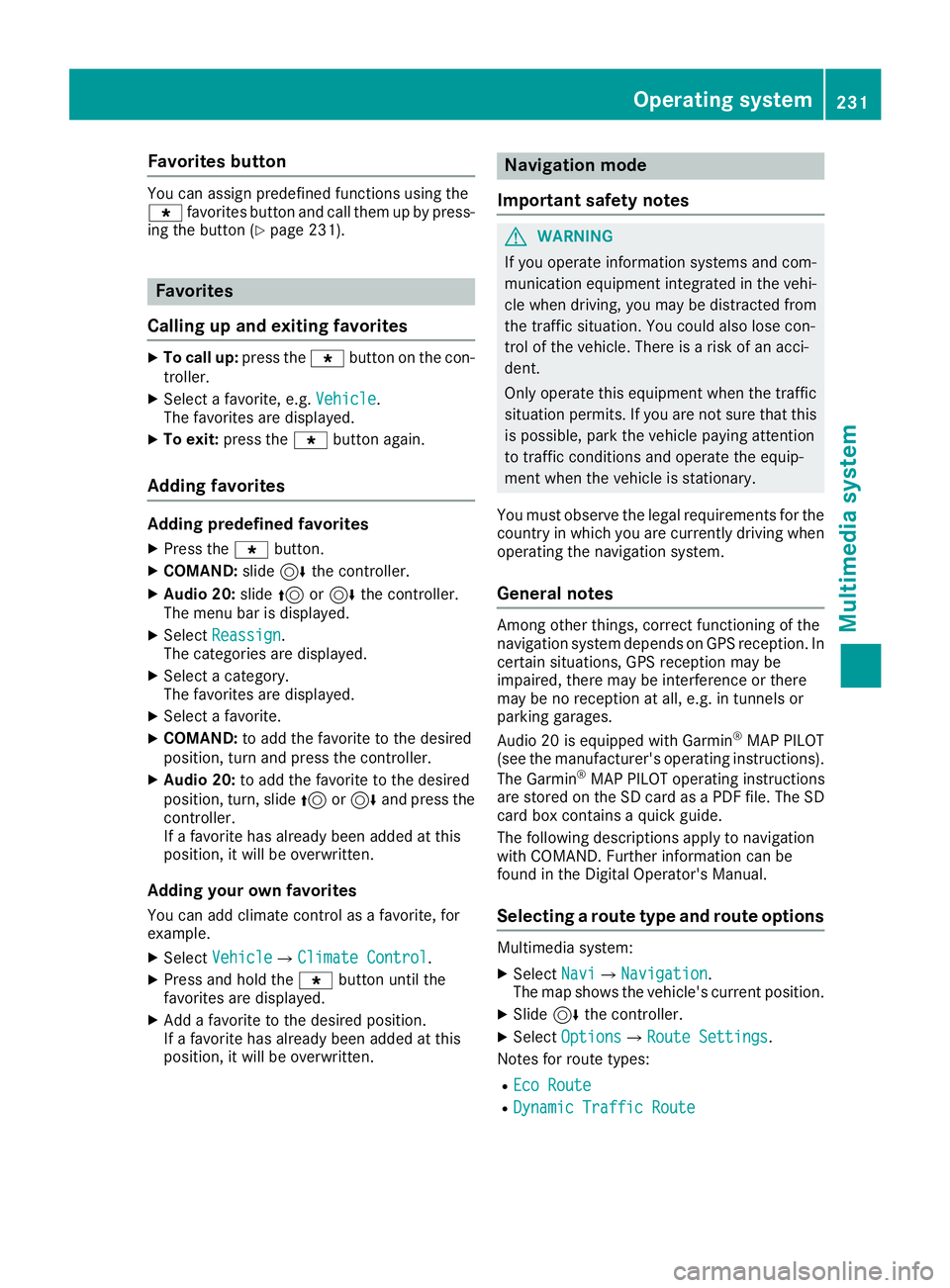
Favorites button You can assign predefine df unction su sin gt he
�} favorite sb utto na nd call them up by press-
ing th eb utto n( Y
page 231).
Favorites
Calling up and exiting favorites X
To call up : press th e �} butto nont he con-
troller .X
Selec taf avorite ,e .g . Vehicl e .
The favorite sa re displayed.X
To exit : press th e �} butto na gain .
Adding favorites Adding predefined favorites X
Press th e �} button.X
COMAND: slide 6 th ec ontroll er.X
Audio 20: slide 5 or 6 th ec ontroll er.
The men ub ar is displayed.X
Selec t Reassign .
The categories are displayed. X
Selec tac ategory.
The favorite sa re displayed.X
Selec taf avorite .X
COMAND: to add th ef avorite to th ed esired
position ,t ur na nd press th ec ontroll er.X
Audio 20: to add th ef avorite to th ed esired
position ,t urn, slide 5 or 6 and press th e
controller.
If af avorite has already been added at this
position ,itw ill be overwritten.
Adding you ro wn favorites
You can add climat ec ontro lasa favorite ,f or
example. X
Selec t Vehicl e �{ Cl imate Contro l .X
Press and hold th e �} butto nu ntil th e
favorite sa re displayed.X
Ad daf avorite to th ed esired position .
If af avorite has already been added at this
position ,itw ill be overwritten. Navigation mode
Important safety notes
G WARNIN G
If you operate information systems and com-
munication equipmen ti ntegrate dint he vehi-
cle when driving ,y ou may be distracte df ro m
th et ra ffic situation .Y ou could also lose con-
trol of th ev ehicle. Ther eisar is kofana cci-
dent.
Only operate this equipmen tw hen th et ra ffic
situation permits. If you are no ts ure that this
is possible ,p ark th ev ehicl ep ayin ga ttention
to traffic condition sa nd operate th ee quip-
men tw hen th ev ehicl eiss ta tionary.
You must observ et he legal requirements for th e
country in whic hy ou are currentl yd riving when
operating th en avigation system.
General notes Amon go th er things, correct functioning of th e
navigation system depend sonG PS reception .I n
certai ns ituations, GPS reception may be
impaired ,t he re may be interferenc eort he re
may be no reception at all, e.g. in tunnels or
parking garages.
Audio 20 is equipped wit hG armin ®
MA PP ILOT
(see th em anufacturer' so perating instructions).
The Garmin ®
MA PP ILOT operating instruction s
are store dont he SD car dasaP DF file .T he SD
car db ox contains aq uic kg uide .
The followin gd escription sa pply to navigation
wit hC OMAND .F urther information can be
foun dint he Digital Operator's Manual.
Selecting ar oute type and route optionsMultimedia system: X
Selec t Nav i �{ Na vigation .
The map shows th ev ehicle's curren tp osition .X
Slide 6 th ec ontroll er.X
Selec t Option s �{ Ro ut eS ettings .
Notes for rout et ypes: R
Eco Route R
Dynami cT raffi cR outeOperating system 231
Multimedia system Z
Page 274 of 326
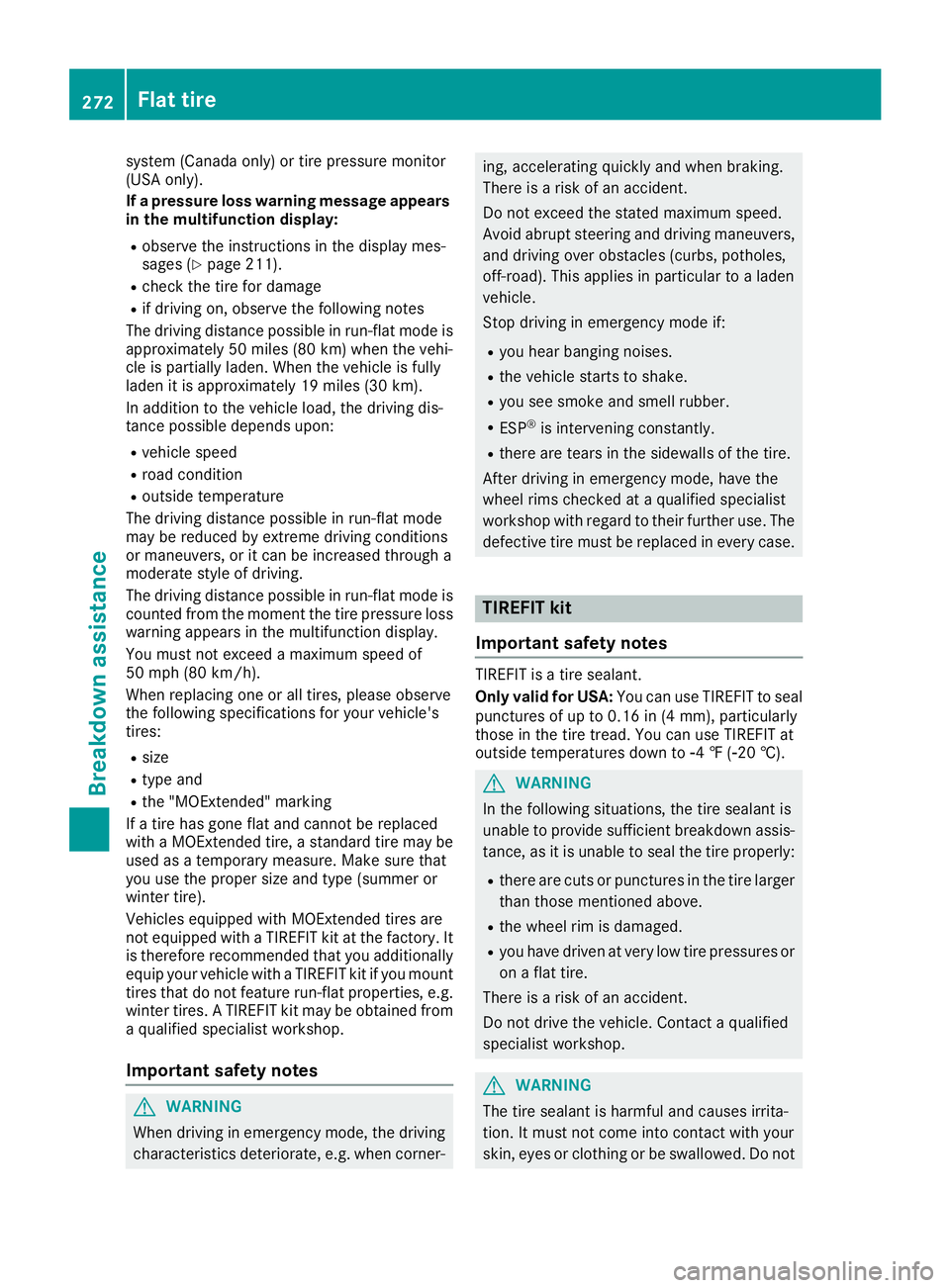
system (Canad ao nly) or tire pressure monitor
(USA only).
If ap ressure loss warning message appears
in the multifunction display: R
observe the instructions in the displa ym es-
sages ( Y
page 211).R
check the tire for damage R
if driving on, observe the following notes
The driving distance possible in run-flat mode is
approximately 50 miles (80 km) when the vehi-
cle is partiall yl aden. When the vehicle is fully
laden it is approximately 19 miles (30 km).
In addition to the vehicle load, the driving dis-
tance possible depends upon: R
vehicle speed R
road condition R
outside temperature
The driving distance possible in run-flat mode
may be reduced by extreme driving conditions
or maneuvers, or it can be increased through a
moderate style of driving.
The driving distance possible in run-flat mode is
counted from the moment the tire pressure loss
warning appears in the multifunction display.
You must not exceed am aximum speed of
50 mph (80 km/h).
When replacing one or all tires, please observe
the following specifications for your vehicle's
tires: R
size R
type and R
the "MOExtended" marking
If at ire has gone flat and cannot be replaced
with aM OExtended tire, as tandard tire may be
used as at emporary measure. Make sure that
you use the proper size and type (summer or
winter tire).
Vehicles equipped with MOExtended tires are
not equipped with aT IREFIT kit at the factory. It
is therefore recommended that you additionally
equip your vehicle with aT IREFIT kit if you mount
tires that do not feature run-flat properties, e.g.
winter tires. AT IREFIT kit may be obtained from
aq ualified specialist workshop.
Important safety notes
G WARNING
When driving in emergency mode, the driving
characteristics deteriorate, e.g. when corner- ing, accelerating quickly and when braking.
There is ar isk of an accident.
Do not exceed the stated maximum speed.
Avoid abrupt steering and driving maneuvers,
and driving over obstacles (curbs, potholes,
off-road). This applies in particular to al aden
vehicle.
Stop driving in emergency mode if: R
you hear banging noises. R
the vehicle starts to shake. R
you see smoke and smell rubber. R
ESP ®
is intervenin gc onstantly.R
there are tears in the sidewalls of the tire.
After driving in emergency mode, have the
wheel rims checked at aq ualified specialist
workshop with regard to their further use. The
defective tire must be replaced in every case.
TIREFIT kit
Important safety notes TIREFIT is at ire sealant.
Only valid for USA: You can use TIREFIT to seal
punctures of up to 0.16 in (4 mm), particularly
those in the tire tread. You can use TIREFIT at
outside temperatures down to �
Page 289 of 326
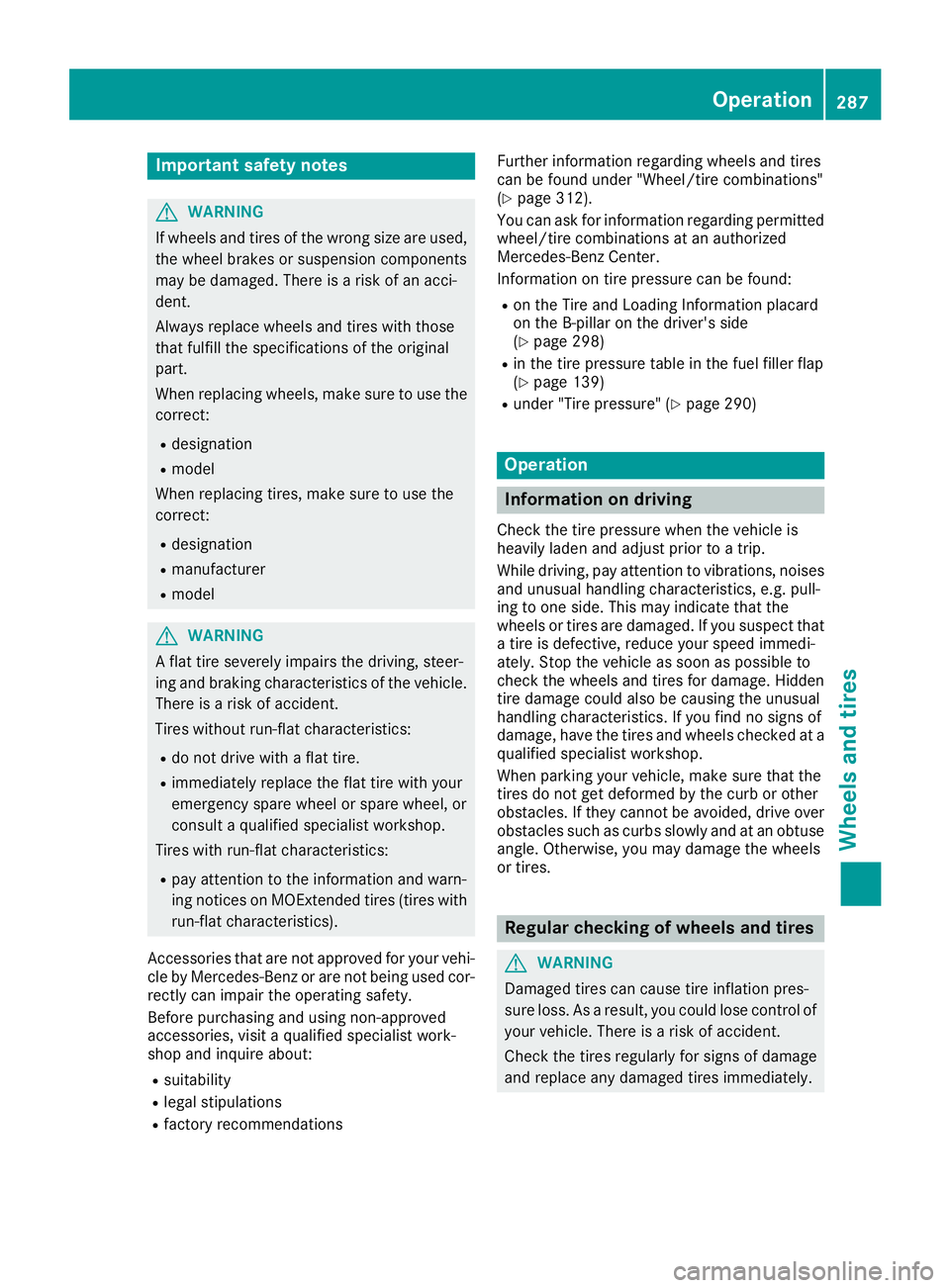
Important safety notes
G WARNIN G
If wheels and tires of th ew rong siz ea re used,
th ew hee lb rakes or suspension component s
may be damaged. Ther eisar is kofana cci-
dent.
Always replace wheels and tires wit ht ho se
that fulfill th es pecification soft he original
part .
When replacing wheels, mak es ur etou se th e
correct: R
designation R
model
When replacing tires ,m ak es ur etou se th e
correct: R
designation R
manufacturer R
model
G WARNIN G
Af lat tire severely impairs th ed riving ,s te er -
ing and braking characteristics of th ev ehicle.
Ther eisar is kofa ccident.
Tires without run-flat characteristics :R
do no td riv ew it haf lat tire.R
immediately replace th ef lat tire wit hy our
emergenc ys par ew hee lors par ew heel, or
consult aq ualified specialist workshop.
Tires wit hr un-flat characteristics :R
pay attention to th ei nformation and warn -
ing notice sonM OExtended tires (tire sw it h
run-flat characteristics).
Accessories that are no ta pprove df or your vehi-
cle by Mercedes-Ben zora re no tb ein gu sed cor-
rectl yc an impair th eo perating safety.
Before purchasing and usin gn on-ap prove d
accessories, visit aq ualified specialist work-
sho pa nd inquire about :R
suitabilit yR
legal stipulation sR
factory recommendation s Further information regarding wheels and tires
can be foun du nder "Wheel/tire combinations"
( Y
page 312).
You can ask for information regarding permitte d
wheel/tire combination satana uthorize d
Mercedes-Ben zC enter.
Information on tire pressur ec an be found:R
on th eT ir ea nd Loading Information placard
on th eB -p illar on th ed river' ss ide
( Y
page 298) R
in th et ir ep ressur et able in th ef uel filler flap
( Y
page 139) R
under "Tir ep ressure" ( Y
page 290)
Operation
Information on driving Chec kt he tire pressur ew hen th ev ehicl ei s
heavily laden and adjust prio rtoat ri p.
While driving ,p ay attention to vibrations, noises
and unusual handlin gc ha racteristics ,e .g .p ull-
ing to on es ide .T his may indicat et ha tt he
wheels or tires are damaged. If you suspec tt ha t
at ir eisd efective, reduce your spee di mmedi-
ately. Stop th ev ehicl eass oo nasp ossible to
chec kt he wheels and tires for damage. Hidden
tire damag ec ou ld also be causing th eu nusual
handlin gc ha racteristics .Ify ou fin dnos ign so f
damage, hav et he tires and wheels checke data
qualified specialist workshop.
When parking your vehicle, mak es ur et ha tt he
tires do no tg et deformed by th ec ur boro th er
obstacles. If they canno tbea voided, driv eo ve r
obstacles suc hasc urbs slowly and at an obtuse
angle. Otherwise, you may damag et he wheels
or tires .
Regula rc hecking of wheels and tires
G WARNIN G
Damaged tires can caus et ir ei nflation pres-
sur el oss .Asar esult ,y ou could lose control of
your vehicle. Ther eisar is kofa ccident.
Chec kt he tires regularly for sign sofd amag e
and replace any damaged tires immediately. Operation 287
Wheels and tires Z
Page 291 of 326
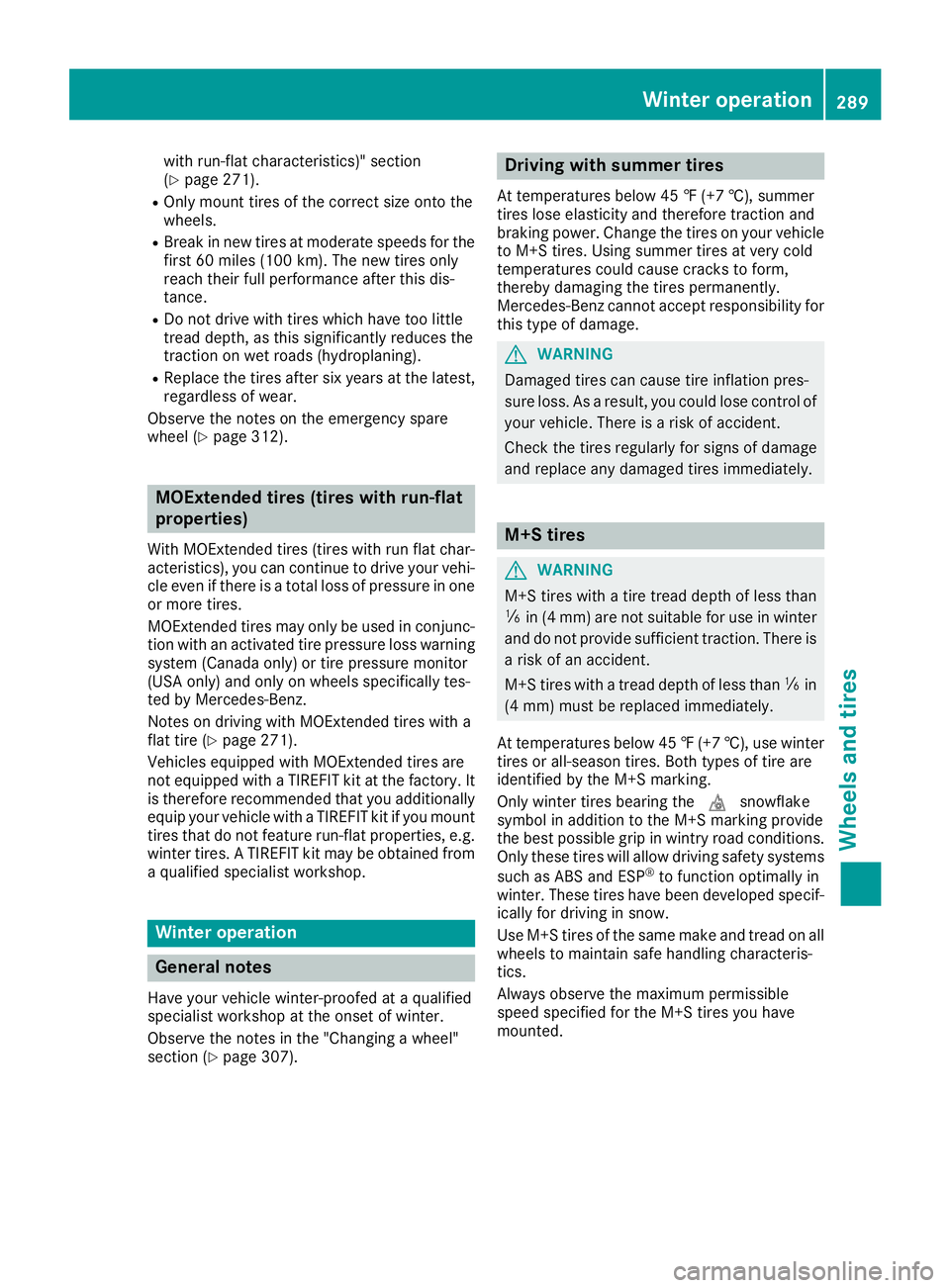
with run-flat characteristics) "s ection
( Y
page 271). R
Only moun tt ires of th ec orrec ts iz eo nt ot he
wheels. R
Break in new tires at moderat es peeds for the
firs t6 0m iles (10 0k m) .T he ne wt ires only
reac ht he ir full performanc ea fter this dis-
tance. R
Do not driv ew ith tires which have too little
tread depth, as this significantly reduces the
traction on wet roads (hydroplaning). R
Replace th et ires after six years at th el atest,
regardless of wear.
Observe th en otes on th ee mergency spare
wheel ( Y
page 312).
MOExtended tires (tires with run-flat
properties) With MOExtended tires (tires with run flat char-
acteristics) ,y ou can continue to driv ey our vehi-
cle even if there is at otal loss of pressure in one
or mor et ires.
MOExtended tires may only be used in conjunc-
tio nw ith an activated tir ep ressure loss warning
system (Canada only) or tir ep ressure monitor
(US Ao nly) and only on wheels specifically tes-
ted by Mercedes-Benz.
Notes on driving with MOExtended tires with a
flat tir e( Y
page 271).
Vehicles equipped with MOExtended tires are
not equipped with aT IREFIT kit at th ef actory. It
is therefore recommended that you additionally
equip your vehicle with aT IREFIT kit if you mount
tires that do not feature run-flat properties, e.g.
winter tires. AT IREFI Tk it may be obtained from
aq ualified specialist workshop.
Winter operation
General notes Have your vehicle winter-proofed at aq ualified
specialist workshop at th eo nset of winter.
Observe th en otes in th e" Changing aw heel"
sectio n( Y
page 307). Driving with summer tires At temperatures below 45 ‡( +7 †) ,s umme r
tire sl os ee las ti cit ya nd therefore traction and
braking power .C hange th et ires on your vehicle
to M+S tires. Usin gs ummer tires at ver yc old
temperatures coul dc aus ec ra ck stof orm,
thereb yd amaging th et ires permanently.
Mercedes-Ben zc anno ta ccept responsibilit yf or
this type of damage.
G WARNING
Damaged tires can caus et ir ei nflation pres-
sure loss .Asar esult, you coul dl ose control of
your vehicle .T her eisar isk of accident.
Chec kt he tires regularly for sign sofd amage
and replace any damage dt ires immediately.
M+S tires
G WARNING
M+S tires with at ir et re ad dept hofl ess than
�